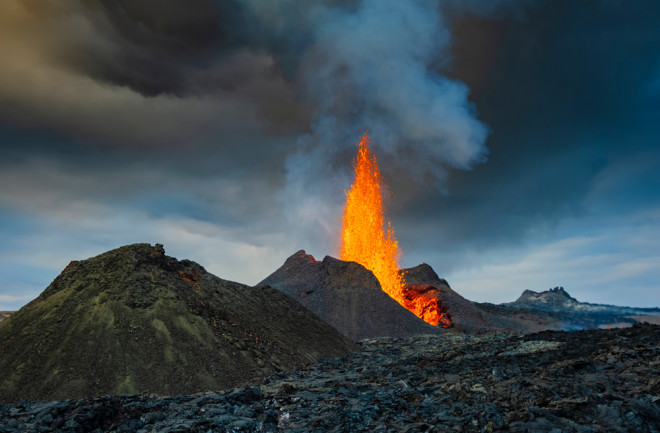At the dawn of the Triassic period, about 252 million years ago, the ancient supercontinent of Pangea stretched between the ends of the Earth. The landmass contained the geologic precursors of all seven modern day continents.
“An ambitious dinosaur could have walked from very close to the south pole to the north pole in a lifetime,” explains Columbia University Paleontologist Paul Olsen.
However, the supercontinent began to rift and splinter in the late Triassic about 230 million years ago. As the Americas pulled away from Africa and Eurasia, magma erupted at the margins. The episode, now known as the Central Atlantic Magmatic Province (CAMP), was one of the largest volcanic events in Earth’s history.
Like the Siberian Traps, the period of volcanism that triggered the End-Permian mass extinction, CAMP had a devastating effect on global biodiversity. Greenhouse gasses spewed into the atmosphere and global temperatures rose rapidly. Organisms on land and in the oceans died en masse. However, many scientists also point to the end-Triassic as the event that gave rise to the dinosaurs.
End-Triassic Fossils From the Ocean
A day's drive from Los Angeles, an old mining road winds into the desert and ends at a gently sloping juniper-studded canyon. This site, dubbed New York Canyon, contains layers of marine sediment that date back to the end-Triassic extinction.
“It’s a pretty complete look at what was going on in a marine shelf environment at the time,” says University of Southern California Paleontologist David Bottjer.
The fossils found in sediments like those in New York Canyon paint a bleak picture of life in the oceans during the late Triassic. Carbon dioxide and heavy metals contaminated and acidified seawater. Two groups of marine mollusks, the ammonoids and conodonts, were wiped out completely, and many other marine organisms suffered catastrophic losses. A majority of species of coral reefs, bivalves and marine reptiles perished.
Though life in the oceans suffered a considerable loss of diversity during the extinction, most taxonomic groups made it through to the other side. When marine ecosystems rebounded during the early Jurassic period, it looked like what had come before.
“It was a mass extinction that happened to the modern fauna,” Bottjer says. “The organisms that survived then re-evolved in the oceans.”
Head for the Poles
On land, organisms are even more vulnerable to extreme weather than their marine counterparts. While the ocean provides a buffer to the changes of atmospheric temperature, land organisms have nowhere to hide. During the late Triassic, the Earth became so hot that few plants or animals could survive in equatorial and tropical regions.
Even so, the period was not universally hot. “Volcanic winters” followed significant eruptions. As ash blocked out sunlight from pole to pole, temperatures plummeted and plants struggled to photosynthesize.
In the late Triassic, a clade of large reptiles, Pseudosuchia, were widespread in equatorial and tropical regions. Few of these cold-blooded scavengers and predators survived the end-Triassic. In a recent paper, Olsen and an international group of colleagues point to volcanic winters as a major driver of these extinctions.
“Everything in the tropics that was large and uninsulated is gone,” Olsen says.
The Psuedosuchians lacked something important: a winter coat. They couldn’t flee the extreme heat to further latitudes because of the risk of freezing to death during a volcanic winter.
But one clade of reptiles was already adapted to the cold. Early dinosaurs had developed insulating coats of feathers to access the rich vegetation found closer to the poles. This adaptation may have led them to survive the extinction and populate the Earth during the Jurassic.
Dinosaurs weren’t the only terrestrial animals to survive the end-Triassic. Proto-mammals may have burrowed into the ground to escape extreme temperatures. Crocodilians, the only surviving order of Pseudosuchia, may have soaked in the water to escape the extreme heat.
The earth’s temperature is rising today as it was at the tail end of the Triassic. Already we are seeing that temperature-sensitive organisms are the first to go. The further global warming advances, the more organisms will be pushed beyond their limits. Those that survive will be adaptable. And, like the dinosaurs, they will inherit the earth.
Read more about dinosaur extinction:

